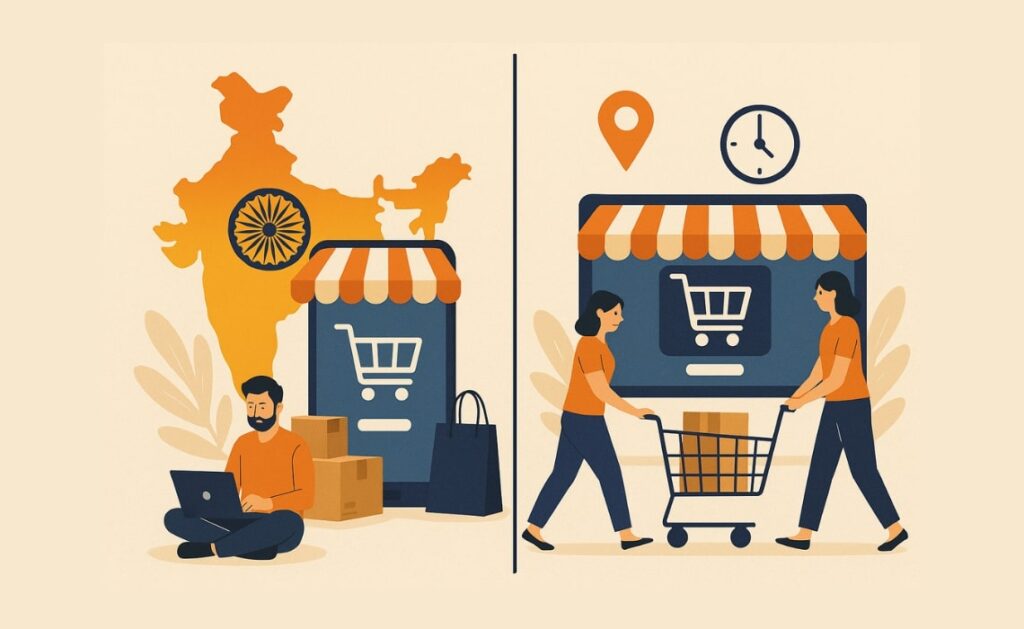Table Of Content
- Why Indian E-commerce Marketing is Different
- 1. Diverse Consumer Behavior
- 2. Regional Languages Rule
- 3. Trust Deficit
- 4. Cash vs Digital Payment Habits
- 5. Hyper-Competitive Ecosystem
- The Biggest Mistakes Indian E-commerce Brands Make
- 1. Copy-Pasting Western Playbooks
- 2. Neglecting Regional Content
- 3. Over-Optimizing for Vanity Metrics
- 4. Ignoring Trust Signals
- 5. Not Localizing Offers
- Core E-commerce Marketing Strategies That Work in India
- 1. Hyper-Local Storytelling
- 2. Invest in Regional SEO
- 3. WhatsApp Marketing
- 4. Leveraging UPI-First Offers
- 5. Influencer Marketing — But Regional
- 6. Festive and Regional Calendars
- 7. Build Trust Everywhere
- 8. Retention Over Acquisition
- How to Budget for E-commerce Marketing in India
- A Practical Marketing Budget Split
- Small Brands, Smaller Budgets
- Tools to Power Your Indian E-commerce Marketing
- Content & SEO
- Ads & Analytics
- Community & CRM
- E-commerce Operations
- Influencer & Social Media
- My Personal E-commerce Marketing Checklist for 2025
- Q1. What is the best marketing strategy for small e-commerce businesses in India?
- Q2. How much should I spend on e-commerce marketing in India?
- Q3. Is influencer marketing worth it in India for e-commerce?
- Q4. Should I use Hindi or English for my e-commerce marketing?
- Q5. What tools should I use for e-commerce marketing in India?
- Q6. How important is local SEO for Indian e-commerce businesses?
- Final Thoughts
When it comes to e-commerce marketing in India, there’s a harsh truth few want to admit:
“Most marketing advice floating around the internet doesn’t work in Bharat.”
Over the past 20 years, I’ve sat in corporate boardrooms and stood inside dusty startup warehouses. I’ve witnessed well-funded brands burn through crores on “one-size-fits-all” digital strategies — only to discover that Indian consumers simply don’t behave like Western ones.
That’s why I wrote this guide. No fluff. No generic tips. Just founder-tested strategies that actually help you sell, scale, and survive in India’s fiercely competitive e-commerce scene.
Whether you’re a solo founder bootstrapping your dream or running a D2C brand aiming for unicorn status, this blueprint is for you.
Let’s dive in.
Why Indian E-commerce Marketing is Different

India isn’t a single market. It’s many markets stitched together — each with its quirks, languages, spending habits, and cultural triggers.
Here’s why generic “global” advice often fails in India:
1. Diverse Consumer Behavior
A buyer in Mumbai’s urban pockets might purchase because your Instagram Reel “looked classy.” Meanwhile, someone in Tier-3 Odisha might still trust a WhatsApp message over a flashy ad.
Behavior shifts dramatically across:
- Urban vs rural audiences
- Age groups
- Languages spoken
- Socio-economic classes
Therefore, one-size strategies simply don’t fit here.
2. Regional Languages Rule
English might dominate startup Twitter. However, e-commerce marketing in India belongs to regional tongues:
- Hindi
- Bengali
- Marathi
- Tamil
- Telugu
- And dozens more
Brands ignoring regional content miss out on over 500 million internet users who’d rather shop in their mother tongue.
(See my Power of Local Language Marketing in Indian Ecommerce article for deeper insights.)
3. Trust Deficit
Indian consumers have been burned before:
- Fake products
- Scammy websites
- Cash-on-delivery nightmares
Unlike Western buyers, Indians demand more proof and reassurance:
- Reviews in their language
- Familiar payment gateways
- Clear return policies
- Trust badges from known authorities
4. Cash vs Digital Payment Habits
UPI has transformed Indian e-commerce. Yet:
- Many still prefer Cash-on-Delivery (COD)
- High-value purchases remain a trust challenge
- Rural pockets lack seamless digital infrastructure
Hence, your marketing message must anticipate these hesitations.ns.
5. Hyper-Competitive Ecosystem
Thousands of D2C brands launch yearly. Meanwhile, big players dominate categories from groceries to fashion. Consequently, customer acquisition costs (CAC) have skyrocketed in metros.
Standing out requires sharper, localized marketing — not simply bigger budgets.
Key takeaway:
“In India, marketing is less about hacks — and more about understanding people.”
The Biggest Mistakes Indian E-commerce Brands Make
Over the last two decades, I’ve seen countless e-commerce founders repeat the same painful mistakes. Let’s save you that heartbreak (and money).
Here’s what not to do in Indian e-commerce marketing:
1. Copy-Pasting Western Playbooks
Many Indian startups think:
“If it worked for a US brand, it’ll work here.”
Wrong.
- Western consumers pay upfront. Indians still love COD.
- Western buyers trust online-only brands. Indians look for social proof and regional validation.
- Western ad costs differ vastly from Indian CPCs and CPMs.
Never assume Western case studies will translate perfectly to Bharat.
2. Neglecting Regional Content
Brands writing everything in English alienate half their potential market.
Consider this:
- 52% of internet users in India prefer content in regional languages.
- Ads in local languages drive higher trust and engagement.
If your marketing ignores this, you’re leaving money on the table.
3. Over-Optimizing for Vanity Metrics
Impressions, likes, views… they look good on a report but often don’t pay the bills.
I’ve watched brands burn lakhs chasing:
- Viral Reels
- Fancy influencers
- Paid PR for empty coverage
Instead, focus on metrics that lead to revenue:
- Cost per acquisition
- Repeat purchase rates
- Average order value
- Lifetime customer value
4. Ignoring Trust Signals
In India, skepticism runs deep. Especially online.
Mistakes that kill trust:
- No customer reviews
- Vague return policies
- Hidden shipping charges
- Zero regional language support
Every piece of your marketing must prove you’re legit.
5. Not Localizing Offers
National “one-price-fits-all” campaigns rarely work. Regional income levels differ. Festivals differ. Even shopping triggers differ.
Example:
- A discount for Diwali might work in North India but mean little in Kerala, where Onam is the bigger festival.
Local context matters.
Key takeaway:
“Indian e-commerce marketing punishes shortcuts — and rewards those who genuinely understand Bharat’s buyers.”
Core E-commerce Marketing Strategies That Work in India
So what does work?
After 20 years in trenches, here’s my blueprint for marketing that moves the needle in India.
1. Hyper-Local Storytelling
Forget generic brand messaging. Tell stories that feel local:
- Showcase regional festivals
- Feature local customers in testimonials
- Speak the cultural language of your audience
Example:
A saree brand using a real customer’s story from Varanasi, written in Hindi, outperformed English campaigns by 4X in engagement.
2. Invest in Regional SEO
If you sell regionally, optimize for regional search terms:
- “Cotton sarees in Bhubaneswar”
- “Organic spices in Pune”
- “Best handloom kurti shop in Lucknow”
Local search is often low competition yet high-intent.
3. WhatsApp Marketing
For many Indians, WhatsApp is the internet. Smart brands:
- Send catalogues
- Share order updates
- Run customer service
- Send festival offers in local languages
But don’t spam. Personalization is the key.
4. Leveraging UPI-First Offers
Encourage digital payments by offering:
- ₹50 cashbacks for UPI orders
- Discounts for prepaid purchases
Indians love small savings—and UPI adoption is booming.
5. Influencer Marketing — But Regional
Instead of big Bollywood influencers, work with regional micro-influencers:
- Smaller audiences but higher trust
- Often more cost-effective
- Better engagement in local languages
A small food influencer in Assam may convert better for an organic spice brand than a national celebrity chef.
6. Festive and Regional Calendars
Indians shop heavily around festivals. Plan campaigns around:
- Diwali
- Durga Puja
- Onam
- Pongal
- Bihu
- Local fairs and melas
But remember: regional context changes everything.
7. Build Trust Everywhere
Include trust signals across your marketing:
- Product reviews
- Regional testimonials
- COD availability
- Clear refund policies
- Regional support numbers
Indians buy more confidently when they feel safe.
8. Retention Over Acquisition
Acquiring a customer in India is expensive. Retaining them is cheaper:
- Use personalized follow-ups
- Launch loyalty programs
- Offer special deals for repeat buyers
Your marketing shouldn’t stop after the first purchase.
Key takeaway:
“E-commerce marketing in India isn’t about shouting louder. It’s about speaking Bharat’s language—literally and culturally.”
How to Budget for E-commerce Marketing in India
Let’s talk money.
Many founders ask me:
“How much should I spend on marketing?”
There’s no one-size-fits-all answer—but here’s a practical guide from my 20 years in the trenches.
A Practical Marketing Budget Split
If you’re an early-stage D2C brand (₹10-50 lakhs/month in revenue), consider this split:
- 30% Paid Ads (Meta, Google, YouTube Shorts)
- Focus on retargeting and bottom-of-funnel campaigns rather than pure reach.
- 25% Content Marketing & SEO
- Blogs, regional content, YouTube videos, reels, and local SEO.
- 15% Influencer & Community Building
- Regional micro-influencers and brand communities.
- 10% WhatsApp Marketing & SMS
- Personalised drip campaigns, order updates.
- 10% Trust & UX Investments
- Better website design, faster speed, customer testimonials, review collection tools.
- 10% Experimentation & New Channels
- Test new ideas like voice search, regional podcasts, or AI tools.
Small Brands, Smaller Budgets
If you’re smaller (₹1-5 lakhs/month revenue):
Focus on:
- Regional SEO
- WhatsApp marketing
- Organic social media storytelling
Avoid:
- Expensive pan-India influencer campaigns
- Big-budget PR
Remember: In India, clever beats costly.
Tools to Power Your Indian E-commerce Marketing
Your marketing stack matters. Here’s my recommended toolkit for Indian founders in 2025:
Content & SEO
NeuronWriter or Surfer SEO
→ Write SEO-optimized blog posts targeted to regional keywords.
Canva Pro
→ Quick regional creatives, festival designs, reels thumbnails.
Grammarly or Linguix
→ Fix English & Hinglish grammar for credibility.
Ads & Analytics
- Meta Business Suite
→ Still the #1 platform for reaching Indian audiences. - Google Analytics 4
→ Track how your traffic performs. - Hotjar or Microsoft Clarity
→ See how Indians behave on your site.
Community & CRM
- Kit
→ Excellent for automating email marketing. - WhatsApp Business API
→ The real goldmine in Bharat commerce. - Zoho CRM
→ Affordable, Indian-friendly CRM for scaling brands.
E-commerce Operations
Shiprocket
→ Manage pan-India shipping with COD support.
Instamojo / Razorpay
→ Indian payment gateways that handle UPI, wallets, COD.
Influencer & Social Media
Winkl or Influencer.in
→ Find regional micro-influencers.
Hootsuite or SocialPilot
→ Schedule posts across platforms.
Key takeaway:
“Tools won’t save a weak strategy—but a great strategy becomes unstoppable with the right tools.”
My Personal E-commerce Marketing Checklist for 2025
Let’s wrap up with a quick checklist to guide your marketing this year:
- Have you defined your ideal customer personas—including regional differences?
- Are you creating content in local languages for your core regions?
- Are you tracking metrics beyond vanity likes—like ROAS and customer lifetime value?
- Are you leveraging WhatsApp for marketing and support?
- Do your offers and festivals match local calendars and sentiment?
- Are you collecting and showcasing trust signals across your website?
- Do you have an SEO plan targeting regional long-tail keywords?
- Are you spending wisely—instead of trying to “go national” too soon?
- Are you testing small, learning fast, and iterating?
FAQ — E-commerce Marketing Strategies in India
Q1. What is the best marketing strategy for small e-commerce businesses in India?
For small brands, start with regional SEO, WhatsApp marketing, and authentic social storytelling. Avoid costly influencer campaigns until you’ve validated your audience.
Q2. How much should I spend on e-commerce marketing in India?
A good starting point is around 20-30% of your revenue for marketing, with most going into high-ROI channels like retargeting ads, SEO, and WhatsApp marketing.
Q3. Is influencer marketing worth it in India for e-commerce?
Yes—but focus on micro-influencers in regional markets. Mega influencers are expensive and often bring less ROI.
Q4. Should I use Hindi or English for my e-commerce marketing?
It depends on your audience. For Tier 2 and 3 cities, regional languages like Hindi, Bengali, Tamil, or Telugu can dramatically improve trust and conversion.
Q5. What tools should I use for e-commerce marketing in India?
Start with Meta Ads, Google Analytics 4, Hotjar, FluentCRM, Shiprocket, and Canva Pro. These help you build, analyze, and scale efficiently.
Q6. How important is local SEO for Indian e-commerce businesses?
It’s crucial. Regional search terms often have less competition and higher buyer intent. Local SEO can help small brands compete against bigger names.
Final Thoughts
In conclusion, e-commerce marketing in India isn’t about throwing money at ads or copying global trends. It’s about understanding local behaviors, speaking regional languages, and building trust from the ground up. If you’re a founder navigating this space, focus on authenticity, community, and clarity — not just scale.
Because in Bharat, relevance beats reach. Every time.




